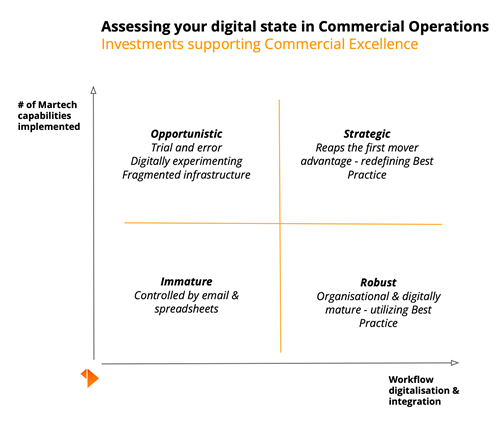4 Key pillars for Digital Maturity in retail operations
Encodify
4 min read

No matter how fast technology moves, here are the foundations you need to ensure that your retail systems and processes are set up to last.
When it comes to digital maturity, Boston Consulting Group found that the most digital mature companies “proved much more resilient during the crisis. After their market valuations took a big hit at the start of the pandemic, these companies quickly rebounded.”
Everyone is after digital maturity, but how much of it is just jumping onto the latest trend? What is it about some companies that makes them more digitally mature than others? What foundations are they built upon? A truly digitally mature company is more than just the latest technology systems, it is about having a mature mindset and way of working ingrained within the organisation. 
If the key foundations are not in place then efforts towards digital maturity are no more than opportunism. So what are the foundations? We’ve signposted how you can prepare for digital maturity in our 4 point guide below.
1. Understand the current state of your commercial operations
When you know the state of your commercial operations, then you know where you’re starting from. You can integrate new marketing technologies, but first find out if your organisation is set up for it. If not, what needs to change in the organisation to ensure it is? We have identified four quadrants illustrating an organisation’s digital states in the journey to digital maturity. To reach digital maturity, the aim is to become highly strategic with robust workflows to support the marketing technologies being implemented. You can’t be digitally mature until you are both opportunistic with robust workflows.
2. Obliterate the silos
Part of robust workflows involves removing the silos. To realise digital maturity within your organisation, everyone needs to be on board, aligned and seamlessly working together - not just in marketing. Martech Series found that 67% of their marketing professionals had to collaborate with others outside of their department in their workflows. The pandemic made working together critical and more challenging because not everybody was physically in the same room. Plus even if internal marketing operations were suitably streamlined, it didn’t mean that other departments, partners and suppliers were. They likely have different ways of working, to varying levels of effectiveness and quality.
But work management technologies have provided ways around this. So, consider how else you can further extend your optimised marketing operations to them, improving workflows for both sides. There is value optimising workflows, not just marketing, but also within and across different commercial teams such as purchasing, category management and sales. It’s very likely many of the key stakeholders for marketing operations are not actually part of the marketing team at all. Therefore, it’s well worth integrating optimised processes that will create value across the whole supply chain - right from a product’s initial concept, all the way to its place on the shop floor.
But it’s not always about people or departmental silos. There are operational ones too. A rising trend, product information management (PIM) systems and digital asset management (DAM) systems are now getting merged together as part of a wider content hub. Before they would frequently sit separately as siloed systems, but many organisations are now realising a single source of truth is a crucial building block in best practice commercial operations.
3. Keep everything going “In Process”
Another part of robust workflows is keeping everything moving through one process. Optimised operations is about doing everything as seamlessly and efficiently as possible. Ideally, one easy straightforward process - whether it’s for your content management, marketing automation or commercial operations. But when systems are siloed, you have separate logins, separate websites, separate administrators and so one campaign could have you in and out of multiple systems. Your process likely feels jagged and disjointed, not at all optimised.
If you’re looking to optimise your operations, make the process the main focus and your starting point. This way, instead of switching in and out of your process, the relevant solution just pops up automatically as and when it needs to. When workflows and operations are optimal, you then also have capacity to look at the finer details - you can smooth out the smaller issues when the larger ones are taken care of.
4. Lead the way!
Remove silos within the organisation, but also look at how you can experiment and be more dynamic working with your partners, suppliers and external stakeholders. If you set the standard and design the way to operate, everyone else will follow.
Take a look at the platforms and people that feed into your business. Chase new opportunities and new innovations, but ensure that workflows and processes s This could be your suppliers and the supplier portal they feed into, it could be your advertising agency and your digital asset management system or your What workflows are they a part of? Are the platforms fit for purpose? How easy is it to feed information into your organisation? Are marketing teams receiving the data they need? You may have an ideal process internally, but it still needs to perform when you scale up and work with others outside of your organisation. If your operations and workflows are awkward, tedious or unsatisfactory, it may well be challenging to get others to use it or to use it effectively.
Work with your technology provider to understand best practice and create ways for others to also fit into and work with your operations. Have a read of our case study with Danish building materials retailer - STARK to find out how they optimised their supplier platform for 623,000 products.
Further guidance can be found on our Resources page. Why not check out our article: 12 ways to increase marketing efficiency through technology?
To discuss your needs and how you can improve digital maturity for your organisation, get in touch with us.









